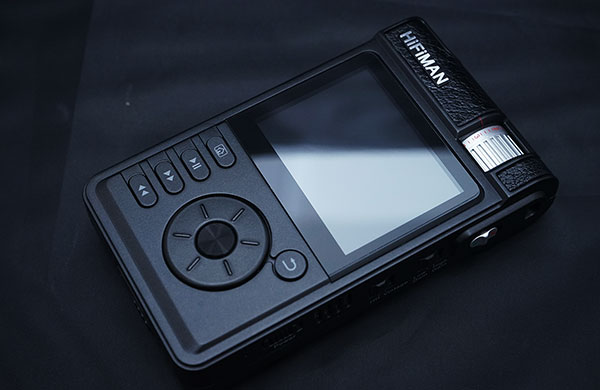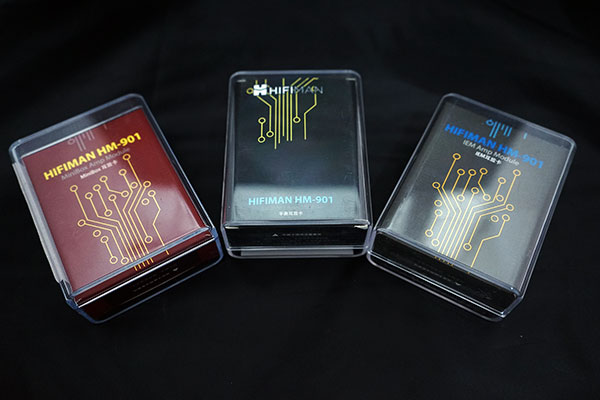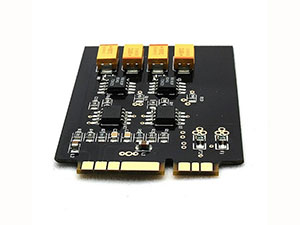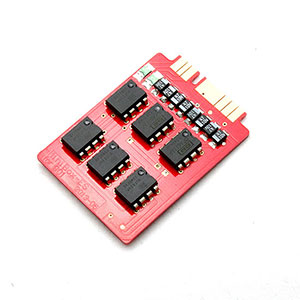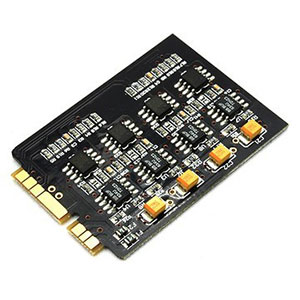Sound Impressions
The HM-901 uses a dual Sabre ES9018 32-bit DAC setup (one for each channel) for decoding which, if implemented correctly, is on a much higher level than the previous Wolfson implementation in the HM-602/1 and the HM-801 series.
The HM-802 series recently launched comes in slightly cheaper and uses a Wolfson setup. The Sabre ES9018 DAC chip is highly regarded, not the cheapest to procure relatively speaking, and also one of the better DAC’s for jitter reduction, advanced digital attenuation, and includes a spdif receiver.
This particular DAC implementation will allow 16-bit formats (mp3, FLAC, ape, aac, alac, AIFF, and WAV) as well as 24-bit formats (mp3, WAV, FLAC, and alac), with decoding for up to 192/24-bit files on the HM-901.
Correct me if I am wrong on this but DSD decoding on the HM-901 will not be a future feature because as far as I am aware the ES9018 is not capable of decoding DSD natively. If and when DSD is a working feature I suspect a flavor of PCM output is more likely even if it can ‘read or handle’ DSD files.
Hifiman has used this otherwise excellent dual DAC setup in combination with an amp modular card system (like the older hm-801) though to give up to four different flavors of sound and it’s this feature that sets it apart, in my opinion, from the other DAP’s out there on the market.
Hifiman has tried this before with the module system on the HM-801 but this time it doesn’t feel like a tagged-on feature. This time it feels more like what I mentioned right at the start, a system DAP.
Choices
Right now there are 4 amp module cards: standard, balanced, Minibox, and the IEM card. Each one is designed with a specific purpose and brings to the table a different quality.
They are not cheap at $230 a card but you do have the choice of which one to get when buying the HM-901, the cheapest being the HM-901 with the standard card at $999. For those looking for a bit more control and less power at 33-65mW for more sensitive IEMs.
The IEM card would be the default choice and for those looking to run balanced (TRRS) and require more power then the balanced card is going to be the logical option reaching up to 477mW in maximum output in balanced high gain mode.
The Minibox is a little bit harder to gauge based on the specs on where it naturally fits but it looks a bit similar to the balanced amp card except with 3 channels and is designed to produce an airy type sound with a better than average soundstage and good detail.
Standard card
Running the HM-901 with the standard amp card is pretty much running the HM-901 in stock mode. It sounds like every inch a good high-end player with excellent dynamics, a weighted bottom end with good detail, a relatively clean and neutral tonality with good transparency though not as warm or dark or tube-like as the older HM series that some people used to adore.
At times that lack of warmth could lean to being bright on some poorly recorded, compressed, or treble demanding tracks, and whilst the soundstage felt like it conveyed decent depth it wasn’t nearly as wide as I felt it could be.
IEM card
Switching to the IEM card and the reduction in power (lower gain) gave me a bit more control with volume using my Merlins and the UE900 universals than the standard card. Mind you when I say a bit more control I topped out at around 4 on the pot before my ears started to take a pounding.
If you don’t plan on using the HM-901 with headphones I would advise sticking with this amp card though oddly enough the UE900 did seem more power-hungry on the IEM card than my Merlins and ran the volume pot about one notch higher.
With the superior control came an added touch of refinement over the sparkier standard card and certainly not as bright though still staying largely neutral with a hint of warmth that I found more satisfying. Bass’s response from the IEM card was really excellent, not overdone, bloated, or boomy – in fact very coherent indeed.
The soundstage is also noticeably wider with the IEM card than the standard card with a slightly more forward midsection. Importantly I experienced no hiss or background noise with both my Merlins and UE900’s during testing with the IEM card which will be a relief for users worried about potential high noise floor levels.
Minibox Card
Changing over to the Minibox amp card, but this time I kept my UE900 jacked in just to get a better point of reference in the differences between it and the IEM card. Again volume control dropped down a notch with the Minibox card but not as low as I thought it would be sitting just above 3 or 1-2 notches below the IEM card.
The biggest difference between the Minibox and IEM is the sense of space and depth – it is an extremely wide and airy soundstage with a heavy emphasis on separation and ambiance.
Vocals are slightly more sibilant on the Minibox card over the IEM card in my opinion with a slightly longer decay than the tighter and more focused IEM module but for surround effects, the Minibox amp card is a lot of fun and I connected with this one for my portable low impedance and IEM’s the most over the review period.
Balanced Card
Saving the best, the most bombastic and the most powerful to the last is the balanced amp card. This is the “Goliath” of the four with the most power and the one that allows proper balanced output if you happen to be running your cans with a TRSS jack. I
stuck with the UE900 again initially even though this is a power card just to get the same point of reference since I was moving from card to card quite a lot.
This is a better card all round than the standard amp card with more power, a fuller richer sound with better dynamics yet still with that original core level of transparency and neutrality from the stock setup.
The balanced card also moves away from the surround-type flavor of the Minibox and presents a more conventional, accurate, and natural sound stage that purists are likely going to prefer.
If I had to pick one card as an audiophile with a mix of cans and IEM’s I would recommend going for the balanced card. Despite its power ratings, you can get above-average performance on IEM’s albeit with a slight loss of volume control as well as being able to throw in more demanding headphones without running out of juice as well as going balanced (TRRS).
I would only suggest the IEM card if you are 100% an IEM guy. The Minibox is a lot of fun, colored maybe, and not as accurate or natural sounding, but that ambiance and super-wide soundstage are really engaging and great to listen to when you just want to lose yourself for a few minutes.
Select Comparisons
FiiO X5
The HM-901 is far more resolving and slightly more neutral-sounding than the FiiO X5. It also comes across as less digital and more natural sounding, especially with the balanced card.
The FiiO X5 is a heck of a lot cheaper than the HM-901, possessing a longer battery life and a UI that is probably a bit more engaging in terms of what you can do with it compared to the more limited and utilitarian Taichi UI of the HM-901.
For those on a tighter budget, the FiiO X5 is an excellent choice but the higher resolution combined with the flexibility of the amp cards and better dynamics put the HM-901 on another level.
A&K AK100
The AK100, the original AK launch unit, has the form factor, longer battery life, and dual MicroSD slots with more onboard memory than the HM-901 and also possesses a nice touch screen UI that is easy to work with.
However, I normally end up pairing the AK100 with my Vorzuge DuoAmp given its rather lackluster performance with IEM’s and a high impedance output. The HM-901 made the AK100 sound extremely digital and cold for me and it didn’t have the same levels of power as the HM-901 especially when used with the balanced card.
Observations
I suspect the real battlefield for the HM-901 is with the AK120 and even the AK100 MK2. Sadly, I do not have either to test – sorry chaps. I do know though that those who have tested the HM-901 against the AK120 have been rather split down the middle.
Some prefer to go with the AK120 on a wide range of factors such as the touch screen, battery life, memory capacity, and the dual Wolfson WM8740 DAC tonality and others prefer the power of the HM-901 and the versatility/tonality of the amp card system.
Also, the very interesting dual Sabre DAC powered Ibasso DX90 is due here in a few weeks so I will add some notes to that review on how it compares to the HM-901. It’s selling for $419 also which could be a very tempting price point for many.
Headphone matching
Mr. Speaker’s Alpha Dogs
Given the HM-901’s relatively neutral tonality, high levels of transparency, and lush fuller sound on the balanced card it was no surprise to find it matched well with a number of harder to drive and headphones even in unbalanced mode.
Planers such as the Alpha Dogs by My Speakers drove really easily on the HM-901 at around 5-6 on the pot and combined with the excellent imaging and micro-detail of the Dogs and the dynamics of the HM-901 on balanced made this a very engaging match.
The relative transparency and neutrality of the HM-901 didn’t color the tonality of the Alpha Dogs thankfully. I know a few are critical of the treble performance of the Alpha Dogs compared to the Mad Dog and Paradox versions which roll off the treble a bit more but that weighted and coherent bass and crystal clear mids are superb on the HM-901 and a pure winner for me.
Audeze LCD-2
Continuing with the planer theme I slipped on the LCD-2 in unbalanced mode and once again volume-wise there were no issues with the LCD-2 which was happy to run at exactly the same level as the Alpha Dogs volume-wise and sounded really alive with a visceral and tight bottom end that really kicked hard and plenty of bass extension and detail.
I won’t go into too much more detail for the new Oppo PM-1 planer as I have a full review of that coming out but bring rated as the most efficient and sensitive planer in the market the HM-901 had zero issues running the PM-1 which displays a thicker more closed in sound that works very well indeed modern pop and rock genres.
Imagine the HD650 a few notches higher in resolution and without that veil and you are not far off the Oppo PM-1 matched with the HM-901 balanced amp card.
Hifiman HE-6
Perhaps the biggest surprise for me was the HE6 and the HM-901. I am usually quite skeptical when it comes to anything other than Class A min of 5 watts per channel and preferably balanced and true enough the HM-901 doesn’t drive as authoritatively as the Mjolnir or the EF6.
What it did seem to manage to do was to give me a competent level of volume control between 7 and 8 without clipping or sounding overly thin or tinny and definitely not sharp.
Outside of the DX100, I think on experience this is probably the only DAP I could recommend at this price point to pair with the HE6 and even then I much prefer the more natural tonality the HM-901 with the balanced amp card over the DX100.
Audio Technica ATH-EWS11
For more portable headphones I actually preferred using the Minibox amp card over the balanced card. For example, my ATH-ESW11 Limited Edition just felt too forced and claustrophobic with the balanced card as well as having to massively reduce the volume (3-4).
Stepping ‘down’ on the power and widening up the frequency was a lot more relaxing and allowed the ESW11LTD to produce a greater sense of space and control.
The Senn Momentum, although at similar reduced volume levels, performed somewhat better than the ESW11LTD sounding slightly less claustrophobic though ending up a bit more sibilant than I would have liked on some vocals with the Minibox amp card.
Our Verdict
Wow-what a journey I have had with the HM-901 and thank you if you managed to get to the end of this review without an overnight sleep! It is probably one of the most engaging DAPs I have used in a while.
Last year this DAP was king of the hill in many people’s eyes and in some respect this year the same is true but now with the advent of the AK240 from Astell & Kern at almost double the price and capable of native DSD playback you have to wonder if Hifiman can keep pace given how long it took to get the HM-901 to the market.
However, if the amp system has a defined roadmap and new modular cards are in development then I can see the HM series continue to have longevity for the purists as well as eat into the portable headphone amp market given its fine performance with everything from CIEM’s to demanding planers.
I just hope future FW’s will continue to expand on the functionality of the Taichi UI and we finally get to see that dock unit in the wild that was promised last year – not that would be something to see!
HIFIMAN HM-901 Technical Specifications
HM-901
- Testing firmware: v1.084 (now superseded by v1.085 as April 9, 2014)
- Dimensions: 72mm W* 117mm H* 29mm D
- Weight: 250g
- Battery life: 9 hours
- D/A Chip: ES9018*2
- LPF: OPA2107*2, OPA627*2
- Headphone Amp Op-amp: AD8397
- Frequency response: 20HZ-20KHz
- Distortion: 0.008%(Line out)
- S/N: 106±4dB
- Memory: 128G SD Slot
Standard Amp Module Card
- Power supply voltage:±8.2v
- Power supply current:±20ma
- Maximum balanced output (30R load)
- Low Gain 0.96v(30mw) High Gain 2.12v(150mw)
- S/N: 109+/-1dB
- Frequency response: 20hz-20Khz(-1.2dB)
- Output impedance: 1 Ohm
The IEM amp module Card
- Power supply voltage:±8.2v
- Power supply current:±20ma
- Maximum output (30R load)
- Low Gain 1v(33mw) High Gain 1.4v(65mw)
- S/N 112+/-2dB
- Maximum current: +47ma/-47ma +59ma/-59ma
- Frequency response: 20hz-20Khz(-0.1dB)
- Output impedance: 2 Ohm
The MiniBox amplifier module Card
- S/N: 108dB
- Frequency response: 20hz-20Khz(-1.2dB)
- Output impedance: 1 Ohm
The Balanced amplifier module Card
- Power supply voltage:±8.2v Power supply current:±20ma
- Maximum balanced output (30R load)
- Low Gain 2.32v(179mw) High Gain 3.91v(477mw)
- S/N: 112+/-1dB
- Frequency response: 20hz-20Khz(-1dB)
- Maximum Normal output (30R load)
- Low Gain 1.45v(70mw) High Gain 2.5v(200mw) S/N: 109+/-3dB
- Frequency response:20hz-20Khz(-1dB)
- Output impedance: 1 Ohm

